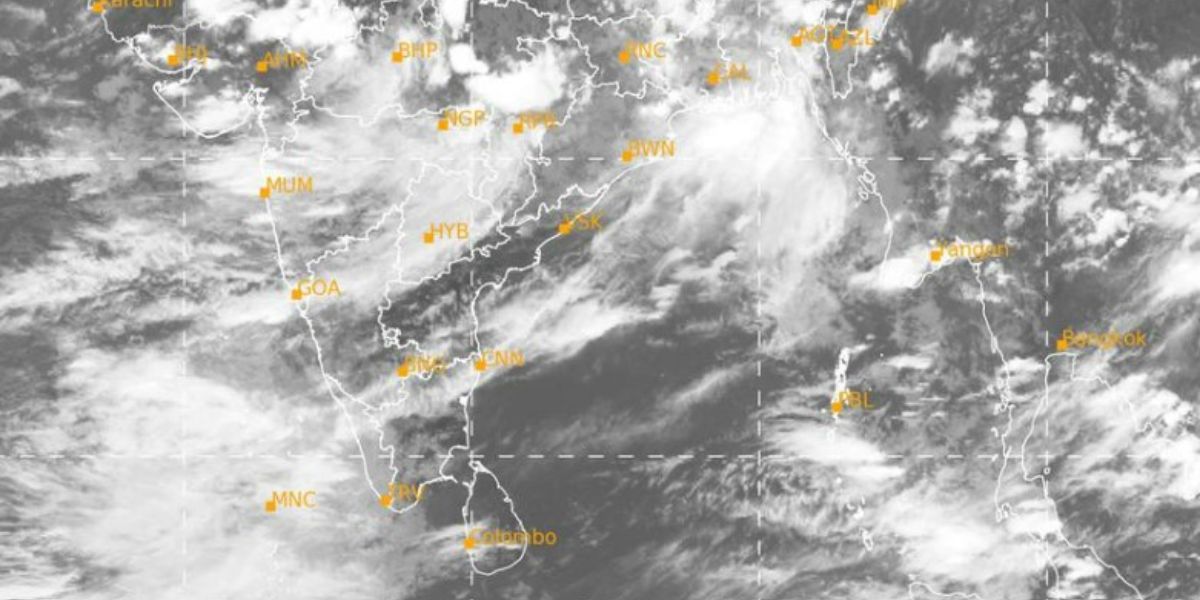All meteorological subdivisions of south India except two –– A&N Islands and TN, Puducherry and Karaikal – have received deficit rain so far.

Monsoon clouds over South India as of 27 June. (IMD) (1)
After a late start and slow pick-up, monsoon rains seemed to gain momentum in the last week of June, though the overall rainfall deficit continues across South India and most parts of the country.
Meteorology Centre Thiruvananthapuram has forecast heavy rains (7–11 cm in a day) in “one or two places“ in Kerala till Friday, 30 June, with some very heavy rain (11–20 cm).
“This is an active phase of the monsoon. We should expect heavy rains till the first week of July,” Madhavan Nair Rajeevan, Ministry of Earth Sciences distinguished scientist at the National Centre for Earth Science Studies (NCESS), Thiruvananthapuram, told South First.
Still, farmers are finding the rain insufficient.
“They report that there were rains, but it is only on paper. We monitor rains locally with automated weather stations, and so far there has not been enough rain,” Joshy Paul, a farmer from Wayanad district, told South First.
It interferes with preparing the fields and had delayed the sowing of rice, he added.
“There have been rare instances of good rain, and we need some flooding to flush out the remnants of the last cropping season,” said a farmer in the Kuttanadu region of Alappuzha district.
“Actually, we don’t mind a minor flood. Kids play in the water and see fish all around.”
For the farmers of Kuttanadu, Kerala’s rice basket that lies partly below the mean sea level, flooding is a part of life, so long as there is no extreme event as it happened in 2018 and 2019 with disastrous effects.
All meteorological subdivisions of South India except two –– Andaman and Nicobar Islands and Tamil Nadu, and Puducherry and Karaikal — have received deficit monsoon rain so far.
When the realised rainfall is more than 60 percent, 20 to 59 percent, and within plus or minus 19 percent of the long period average, the rainfall is called large excess, excess, and normal, respectively.
When it is -59 to -20 percent, and -99 to -60 percent, it is called deficient and large deficient, respectively
Heavy rains in late June could improve the overall rainfall levels to some extent, observers said.
With an active monsoon trough along central India and the warm Bay of Bengal, models suggest the active monsoon will continue for the next four days.
However, there could be a weakening of monsoon as the trough moves northward, Rajeevan said.
The monsoon trough is a low-pressure area that extends from Pakistan to the northern end of the Bay of Bengal. This is one of the semi-permanent features of monsoon circulation.
The east-west orientation of the Himalayan ranges and the north-south orientation of the Khasi-Jaintia Hills influence its movements.
Generally, the eastern side of the monsoon trough oscillates. Southward movement leads to active monsoons over much of India. The northward movement leads to breaks in monsoon and heavy rains along the Himalayan foothills and sometimes floods in the Brahmaputra river, IMD scientists explained.
However, other monsoon watchers see a further strengthening of the monsoon.
“We are expecting some good rains towards the end of the first week of July,” Abhilash Sukumarapillai, director of the Advanced Centre for Atmospheric Radar Research at the Cochin University of Science and Technology told South First.
Madden-Julian Oscillation (MJO) –– a weather system involving clouds, rainfall, winds, and pressure that traverses the tropics –– is expected to become favourable, and there would be some weather systems in the Bay of Bengal and the Pacific together influencing the monsoon, Abhilash said.
MJO is the leading mode of tropical climate variability involving deviations of climatic statistics over a month, a season or a year when compared to long-term statistics. It happens within a season, each cycle lasting 30–60 days.
It has a huge influence on the Indian summer monsoon. It is a massive weather event consisting of deep convection coupled with atmospheric circulation, moving slowly eastward over the Indian and Pacific Oceans, leading to anomalous rainfall globally.

Jul 26, 2024

Jul 26, 2024

Jul 26, 2024

Jul 25, 2024

Jul 25, 2024

Jul 25, 2024